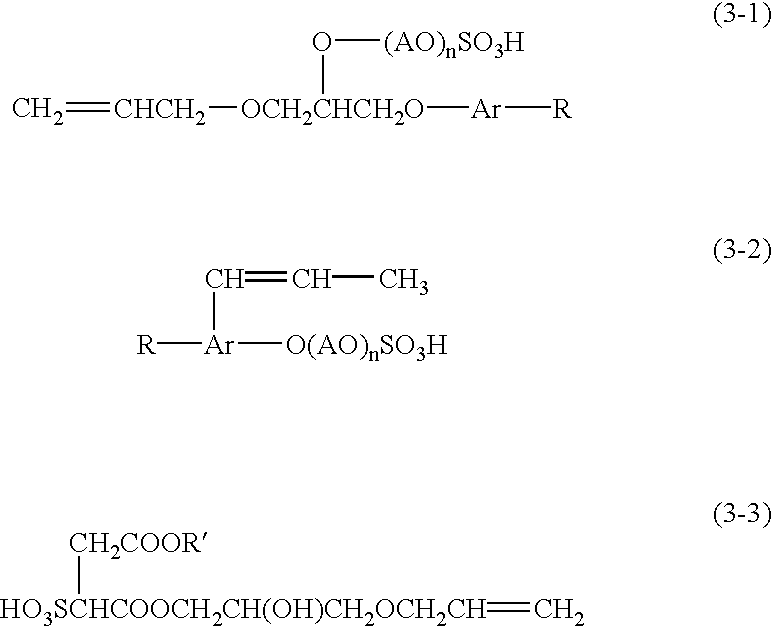Resin dispersions having uniform particle diameters, resin particles and processes for producing both
a technology of resin particles and dispersions, which is applied in the direction of coatings, etc., can solve the problems of adversely affecting the electrical and thermal properties and chemical stability of resin particles, the inability of product particles and the inability to achieve uniform particle diameter. , to achieve the effect of more effective particle diameter uniformity, easy to dissolve or swell in water, and easy to dissolve or swell
- Summary
- Abstract
- Description
- Claims
- Application Information
AI Technical Summary
Benefits of technology
Problems solved by technology
Method used
Image
Examples
production example 1
[0297]A reaction vessel fitted with a stirring rod and a thermometer was charged with 47 parts of styrenated phenol-polyethylene oxide adduct (Eleminol HB-12, product of Sanyo Chemical Industries) and 232 parts of bisphenol A diglycidyl ether (Epikote 828, product of Yuka-Shell) to prepare a homogeneous solution. Under stirring, water was added dropwise into the reaction vessel. When the quantity of water so added had reached 31 parts, the system became emulsified and assumed a milk-white color. Then, 224 parts of water was further added dropwise to give an emulsion (1). After the internal temperature of the system was increased to 70° C. by heating, a solution prepared by dissolving 20 parts of ethylenediamine in 446 parts of water was added dropwise over 2 hours at a constant temperature of 70° C. After completion of dropwise addition, the reaction and ripening were carried out at 90° C. for 5 hours to give an amine-cured epoxy resin aqueous dispersion [a microfine powder dispersi...
production example 2
[0298]A reaction vessel fitted with a stirring rod and a thermometer was charged with 683 parts of water, 11 parts of methacrylic acid-ethylene oxide adduct sulfate ester sodium salt (Eleminol RS-30, product of Sanyo Chemical Industries), 139 parts of styrene, 138 parts of methacrylic acid, and 1 part of ammonium persulfate, and the whole was stirred at 400 rpm for 15 minutes to give a white emulsion. This emulsion was heated to an internal temperature of 75° C. and further reacted at this temperature for 5 hours. Then, 30 parts of 1% aqueous solution of ammonium persulfate was added and the mixture was matured at 75° C. for 5 hours to give an aqueous dispersion of vinyl resin (styrene / methacrylic acid / methacrylic acid-ethylene oxide adduct sulfate ester sodium salt copolymer) [a microfine powder dispersion slurry A2]. The volume average particle diameter of this [microfine powder dispersion slurry A2] as measured with LA-920 was 0.15 μm. A portion of the [microfine powder dispersio...
production example 3
[0299]A reaction vessel equipped with a condenser, stirrer and nitrogen inlet pipe was charged with 343 parts of bisphenol A-ethylene oxide(2 mols) adduct, 166 parts of isophthalic acid, and 2 parts of dibutyltin oxide and the reaction was carried out under atmospheric pressure at 230° C. for 8 hours and further under a reduced pressure of 10 to 15 mmHg for 5 hours. After cooling to 110° C., 17 parts of isophorone diisocyanate in toluene was added and reacted at 110° C. for 5 hours. The solvent was then removed to give a [urethane-modified polyester (1)] with a weight average molecular weight of 72,000 and a free isocyanate content of 0.7%.
[0300]In the same manner as above, 570 parts of bisphenol A-ethylene oxide(2 mols) adduct and 217 parts of terephthalic acid were subjected to polycondensation reaction under atmospheric pressure at 230° C. for 6 hours to give an unmodified [polyester (2)] with a number average molecular weight of 2,400, a hydroxyl value of 51 and an acid value of...
PUM
| Property | Measurement | Unit |
|---|---|---|
| volume average particle diameter | aaaaa | aaaaa |
| volume average particle diameter | aaaaa | aaaaa |
| roughness Ra | aaaaa | aaaaa |
Abstract
Description
Claims
Application Information
 Login to View More
Login to View More - R&D
- Intellectual Property
- Life Sciences
- Materials
- Tech Scout
- Unparalleled Data Quality
- Higher Quality Content
- 60% Fewer Hallucinations
Browse by: Latest US Patents, China's latest patents, Technical Efficacy Thesaurus, Application Domain, Technology Topic, Popular Technical Reports.
© 2025 PatSnap. All rights reserved.Legal|Privacy policy|Modern Slavery Act Transparency Statement|Sitemap|About US| Contact US: help@patsnap.com

